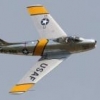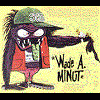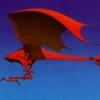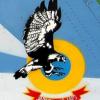-
Posts
252 -
Joined
-
Last visited
About splinter

- Birthday 26/09/1979
Profile Information
-
Gender
Male
-
Location
Croatia
-
Interests
Modern airliners 1/72 1/144 and modern jets 1/72 & 1/48
Recent Profile Visitors
2,619 profile views
splinter's Achievements

Established Member (3/9)
149
Reputation
-

MiG-21UMD CroAF 165 (1:32, Trumpeter + aftermarket + DIY)
splinter replied to splinter's topic in Work in Progress - Aircraft
Mauricio? Manuel? Hi there! I don't remember your real name anymore, but you can greet your mother back in my name. Talking about stressed skin on MiG-21, I remembered this photo (copyright goes to Tomislav Haraminčić). Well, I'm far away from such effect skill. Mr. Surfacer 500 will be good enough this time. As for Su-27, I have it still somewhere. It's unfinished due to several reasons but it will probably remain as such as I have other priorities. There were several attempts to finish it, but with Hobbyboss mold on the market, it sits on the "shelf of doom". Did you finished yours?- 14 replies
-
- 1
-

-
- Croatian Air Force
- Kockica
-
(and 1 more)
Tagged with:
-

MiG-21UMD CroAF 165 (1:32, Trumpeter + aftermarket + DIY)
splinter replied to splinter's topic in Work in Progress - Aircraft
This is leading edge of the vertical tail. I noticed that while the tip (or top) is thin, middle and root sections are transient and thick. I decided to sand 2/3, thus I also had to rebuild panel lines and rivets. Control check after sanding with light shadows. This is very easy way to control progress and final results during sanding. For parachute doors, I used Eduard PE and some lead wire to enhance details. Not much to see here, with Alclad gloss black primer on. Similar shot from different perspective. This is how wide I'll let doors to be open. Finished with ALC-106 White Aluminium, MiG Productions Dark Brown Wash and some acrylic rust spots. Found this 1.5 mm soldering wire in local hardware shop. It will be useful for landing gear bays later. Last thing for today are engine details being painted. By frequent checking of real photos I decided to move Eduard PE part #10 and to give it a new role. Again, these are confusing Eduard instructions. I decided to move this part a bit more aft, at the beginning of tube section, I cut out before. I modified my pliers with a piece of balsa wood, to preserve a slot between jaws. With such pliers I pressed Eduard part #10 over 1.0 mm dia drill bits, held by vice tool. This way I got arc pattern for panels with holes for air cooling. Here is same part after being modified. You can see that thicker, flat panels are left as they are, while air-cooling panels are bent in arc. Paints I used are MrPaint MRP-173 and MRP-104 mixed with MRP-173 in 4:1 ratio. Here is current stage, weathered with pastels. Afterburner ring got Humbrol 27004 Gun Metal, buffed up. And after that I gave some Light Gun Metal powder on front section. I'll add more pastels, once the ring is fixed. Flame stabilizer, first attempt. Too dark weathering. 2nd attempt. Green, dirty and flat coated. Straight exhaust tube section, 1st attempt. Too dark green base with rough surface. Smoothen out to 1500 grid. Current stage, weathered with MRP-173 Rubber Tire. Another angle. Afterburner nozzles with Humbrol 27004. For all three "greenish" engine parts I used same MrPaint mixture (this mixture is close to MRP-131): 12x MRP-32 7x MRP-199 3x MRP-4 For weathering I used overspray of ALC-113 (Jet exhaust) and AK Interactive washes Ak2071 and AK300. For outed side I used Alclad Jet exhaust (with deliberate overspray to inner side) and dry pastels. Front face was weathered with AK086 Dark Steel pigments (also visibile on photos above). That's all for now.- 14 replies
-
- 3
-

-
- Croatian Air Force
- Kockica
-
(and 1 more)
Tagged with:
-

MiG-21UMD CroAF 165 (1:32, Trumpeter + aftermarket + DIY)
splinter replied to splinter's topic in Work in Progress - Aircraft
Currently, I'm more focused on painting APA starter. And just the other days my quick release coupling fell apart. But, with some trials and errors I managed to move forward on MiG, as well. Today, I'll talk more about vertical tail, parachute and parachute housing, VOR antennas and engine painting. First, rear fuselage has been smoothed out. A 1 mm styrene plug inserted next to rear air brake housing. As said before, molds are worn out, so you need to get used to "gaps" and "slots" like these, and fix them. In this case you have to line-up panel lines between vertical and rear fuselage. So I shorten pins for vertical tail. This is better. New VOR/ILS antennas scratchbuild for UMD standard from 0.25 mm styrene and 1.0 mm styrene rod. To create a replica of MiG parachute, I took S-24 rocket from Eduard's 1/48 MiG-21 mold ( I have a few leftovers), cut the middle section (20 mm length, 5 mm diameter) and wrap it with clear kitchen foil. Wood glue is used as a filling. For straps I used narrow JammyDog masking tape - this one is 0.5 mm. Straps are not tight, so glue can be moved between sections. This way I got real 3D texture. For big strap I used waxed cord (0.5 mm), used for DIY jewelry and lead wire 0.2 mm. Waxed cord also has a smooth surface, but with preserved cord texture. Painted with Ammo MiG 4BO surface primer. Note that straps were not painted. Due to worn-out mold, many details are soft. Here I just sanded some plastic flat, to get sharp edge.- 14 replies
-
- 1
-

-
- Croatian Air Force
- Kockica
-
(and 1 more)
Tagged with:
-

MiG-21UMD CroAF 165 (1:32, Trumpeter + aftermarket + DIY)
splinter replied to splinter's topic in Work in Progress - Aircraft
I had to add 0.25 mm strip under middle/front fuselage (parts E21/E29), to get smooth transition to rear fuselage. Now, I have this slot, but that's much better option than to have a radial step, around the fuselage. Not all parts survived transport. Sink marks Soft details on engine. I will not use these parts. Dryfit with middle/front duselage: engine starts just aft of main undercarriage. Here is a ring on inner side of rear fuselage. Nothing will be visible before this ring. Engine fit with exhaust end (part G7). Notice the thickness of this part (trailing edge). Some 90-95% of length. New deflector under the parachute housing being made from copper plate. Not that is has to be bend upwards. Slightly. Rear engine tubing - joint has been smoothen out. There was a step between rear fuselage and exhaust end. I started with heavy sanding. Trailing edge on exhaust end ring being thinned. Coarse sanding. Fine sanding.- 14 replies
-
- 4
-

-
- Croatian Air Force
- Kockica
-
(and 1 more)
Tagged with:
-

MiG-21UMD CroAF 165 (1:32, Trumpeter + aftermarket + DIY)
splinter replied to splinter's topic in Work in Progress - Aircraft
Back to Mongol. I started with the engine. First thing is that I noticed that the engine sprue is not marked as MF or UM. Main reason for this remark is that the flame stabilizer is neither from R-25 nor R-13 engine, but somewhere in between. And this are definitely afterburner nozzles from Chinese copy of MiG-21 engine (called WP-7 or similar). Next to it are Icaerodesign nozzles, which are very good shaped. They look to me as scaled up copy of Eduard's Brassin set for 1/48 scale MiG-21 engine. Also, there is no afterburner control ring, as in Icaerodesign set. As Trumpeter provided engine in 4 parts + Eduard PE + Icaerodesign resin... I had to figure out what is useful at all. First, I chamfered rear end of flame stabilizer so I can move it forward turbine a few milimeters (will need that space in a few moments) 2nd, there is some kind of step coming after the flame stabilizer (middle and up quarters on the photo below), so I flushed both sides and removed the ring at the rear end (bottom 1/4 of the engine). Flame stabilizer being chamfered. Eduards PE part #10, only useful part from PE fret for the engine. Looking at the photos and measuring the diameter on the Trump parts --> only logical position for it would be just aft of the flame stabilizer. This is why I had to move the stabilizer forward. To make all those nasty pin marks and 1/4 joints disappear, I cut a single piece of 0.25 mm styrene, and bent it with scissors. Here you can also see Eduard PE #10 from photo above. On top of that come afterburner nozzles. Good fit, and lucky that those 1/4 joints will not be visible, once the engine is inside the fuselage. After glueing all engine "quarters", I made a radial cut, to gain access to flame stabilizer and to be able to paint central part of the engine from inside. Here is Eduard PE #10 in front of flame stabilizer, after the cut. You can see that one link is missing. I'll add thin aluminium plate here later on. Flame stabilizer being modified - mid phase. And final result. It's still not as on R13 engine, but it's close enough. Behind the flame stabilizer I also added black styrene, to be used as visual barrier and inner structure support. Exhaust end after cut, with styrene tubing (flushed with Mr. Surfacer 500), and resin afterburner. Dryfit with middle section - can't focus on flame stabilizer, sorry. That's all for tonight. Tomislav- 14 replies
-
- 2
-

-
- Croatian Air Force
- Kockica
-
(and 1 more)
Tagged with:
-

MiG-21UMD CroAF 165 (1:32, Trumpeter + aftermarket + DIY)
splinter replied to splinter's topic in Work in Progress - Aircraft
I really don't know if any of our Homeland war books has been translated to English. I made 1/48 Osvetnik Vukovara with their decals a few years back. Decals behaved very good. Good print quality, thin foil, minimal clear edge, good glue, no bubbles ...- 14 replies
-
- 3
-

-
- Croatian Air Force
- Kockica
-
(and 1 more)
Tagged with:
-

MiG-21UMD CroAF 165 (1:32, Trumpeter + aftermarket + DIY)
splinter replied to splinter's topic in Work in Progress - Aircraft
Hi Antoine! It's not a new brand. It seems more like being closed down. http://www.ze-ro-decals.com/- 14 replies
-
- 1
-

-
- Croatian Air Force
- Kockica
-
(and 1 more)
Tagged with:
-
This will be a part of a diorama on a larger scale. I started my APA-5D in 1/35 scale about a year ago, and as comes to painting phase now, I decided to "stretch" it a bit. With MiG-21UMD in 1:32. This is a layout sketch cca. 55 x 40 cm. A is MiG-21UMD, bort no. 165 from Croatian Air Force, after overhaul in 2014. It's our solo display MiG, with red-white livery, called "little cube" or locally "Kockica". Or "flying ILS house", as some call it. B is APA-5D airfield starter, also from Croatian Air Force, currently in painting phase (below). Above is my first APA-5D, finished as example from Voronezh Air Base, Russia, here only for illustrative purposes. Whole WIP for starter is here: C should be a spotter figure from ReedOak. I just cleaned up the figure - removed support struts from 3D printing. All three together should be a nice airshow diorama or vignette. MiG-21 will be on asphalt and spotter and URAL on a grass, next to MiG. Note that display MiG is getting dirty with time, but it's also being freshly repainted, often than any other MiG in Croatian inventory. On the other side, this particular APA starter is more than 20 years old, never overhauled or re-painted, full of rust, paint chipping, etc... A big contrast to MiG on diorama base, for sure. OK, back to MiG. My shopping list. Single available Mongol kit in 1:32. Old mold, crude plastic, full of sink marks and pins.... Eduard PE for MF exterior. I know it's MF, but since there is no PE for UM, some parts can be upgrades with this set as well. Kuvalainen PE for Finnish Mongol cockpit. Finnish Mongols have different arrangement for instrument panels, but I think this could be useful. Eduard masks. Saved me a lot of time for single-seaters in 1:48. Icaerodesign upgrade for MiG-21MF engine - both MF and UM share R-13-300 engine. Begemot stencils. Mostly in Russian. We have mostly translated stencils to Croatian and they should be black for display MiG. For now I'll leave them. Ze-Ro Decals for Croatian UM, but from 90's livery. Both Croatian roundel and national coat of arms are 10-15% smaller than they should be for display MiG after overhaul in 2014. No bort number provided as decal. These were last two examples, I found on web. Master pitot tubes and static dischargers. Quickboost resins for MF, again useful for UM, as well. HAD wheels. HAD ground crew accessories. HAD ejection seats and control sticks. OK, that's all for now. Stay tuned.
- 14 replies
-
- 4
-

-
- Croatian Air Force
- Kockica
-
(and 1 more)
Tagged with:
-
OK, here are few more photos. This will be last update prior painting. Rotating arms - final assembly Cabin interior: seam lines on the seats were removed and upgraded with lead wire 0.2 mm.Ribbed carpets were made with thin aluminium. Driver's carpet was cut in for gas pedal. 2nd auxiliary gearbox handle was added from spares (there should be two, Trump messed up again). I also added another handle next to the steering wheel and a air heater in front of main gearbox handle, to keep that front wall busy. Generator console was scratchbuilt with styrene and 0.6 mm lead wire. Only front PE is from HAD conversion set. How to make roof cover? Enhance edges with pencil, place masking tape on top and repeat lines. Remove masking tape and place it on 0.1 mm copper plate. Cut along lines. Same process done for rear wall cover. I also added roof light. Here you can also see incorrect dryfit for passenger's seat. This is as per Trumpeter instructions: lower seat is far forward compared to floor and there is a big gap to the backrest, which is positioned vertically. Looking at reference photos, I removed front edge on the cabin floor... ... and I added copper strips to the rear, so I can incline backrest. Here is corrected passenger's seat. Lower part is moved back and backrest is inclined. Backrest is on top and not next to lower seat part. Sun shields made from 0.6 copper wire and 0.5 mm styrene ... One small exterior cabin detail added... This panel is again different from Hungarian/Russian starters. Comparison to real thing.... Windscreen wipers ... Trumpeter gives you plastic ones, which are hard to position correctly on windscreen. I started with Voyager PE, and steadily upgraded them ... Shot at strange angles because of gravity. Last detail: interior door cover ... Trump gives you bare metal interior, but Croatian starters have cushioned covers. Not much to see now with bare white styrene. I decided to go with both doors opened. Next thing are priming, painting and final assembly. I'll use HEMMT cabin for paint testing: Mr. Paint, rusting, weathering....
- 15 replies
-
- 1
-

-
Last thing for today are door windows. Trumpeter gives you one piece windows, while in reality it's two - one smaller triangle-shaped and one larger. My first attempt was with 0.5 mm clear styrene (right side). Later, I used 0.25 mm styrene for smaller triangle window. Here is comparison between Trumpeter URAL4320 mirrors and KAMAZ 4310 mirrors from ICM. Acc. to reference photos I needed bigger KAMAZ mirrors. Comparison to real one. And my favorite photo so far - notice how ground crew "hooks" port door with mirror. That's all for this time. Now it's your turn for C&C.
- 15 replies
-
- 2
-

-
Next were smaller hooks, which are more like orifices on top of the rotating arms. Smaller diameter power cables are pulled thru them. I used PE fret given by HAD on my first APA, but as said before this time I'll make new ones, from brass. Main reason for DIY orifices is my wish to pull TWO power cables with bigger diameter thru lower orifice and THREE power cables with smaller diameter thru upper orifice. My first APA-5D has only ONE bigger and ONE smaller diameter cables per each rotating arm. Here is squared lower orifice, as given by HAD. Too small. 0,1 mm brass plate for DIY projects. Cut brass strip with marked sections for each orifice. On the left is original HAD upper orifice, while all other are mine. It's hard to create an arc from HAD parts. Here are upper and lower orifice joined together. Three power cables (ex SCART cable wires) with small diameter are pushed thru upper orifice. All orifices in position and lower are glued to rotating arms. Two power cables with bigger diameter (ex earphones) are positioned for fit. Styrene strip is used to allow small gap between cables and orifices. One of the most fragile resin parts for rotating arms (HAD parts A,B,C). Had to fix them with 0,25 mm styrene and CA glue. Here is another idea from me: I want to re-create mechanism to unlock rotating arms via steel wire and rotating wheel in upper corner of each arm (HAD parts F,G,H). Specifically, here is a test with 0.3 mm red copper wire to test parallel to base of the rotating arm.
- 15 replies
-
- 1
-

-
Full testfit. Air intake for cabin air in extended position - also made from Voyager PE (just in front of the front cabin windows). Rear chassis also got base PE parts for lights. This is from SKP PE set for URAL4320 - this set was fresh from the factory when I got it in Bratislava last December. Here is a detail from that SKP set for URAL 4320. Here I test if one of front headlights could be used for rear position light on starter. I would highly recommend this set to anyone because it's hard to replicate such level of details with own hands.
- 15 replies
-
- 1
-

-
This is PE fret from HAD for "cable hooks" as I call them. My first APA-5D was made with these parts, but for this APA truck I will use just bigger (on the right side), while for smaller (on the left) I will create new from 0,1 mm brass plate It's a bit hard to explain but if you compare parts 31 and 33 from photo above, you may notice that 33 has longer flanks. In reality I didn't notice different flank length, so I shorten them to look same as part 31. Next, HAD suggest to use styrene bar with dia 1mm and to glue PE parts 31-33 to it. I did it on previous APA, but noticed that heavy power cables makes such joints fragile. This time I soldered PE hooks 31-33 to brass wire. I had my mojo to create special device to insure vertical joints. And parallel as well. With parallel joints I already had problems with heat transfer - while soldering upper joint, lower melted. To insure stable joint to the base of rotating arms, I used two-component metal glue. This glue is very liquid during first hour (with 24h total drying time) so I had to think again how to restrict all degrees of freedom during drying. There are some mistakes that HAD has in this conversion set like this last upper hook, which I had to re-create. Glass is used to ensure leveled position, while drill bit gives parallel and equal distance between side strips. First test with assembled cable hooks on rotating arms.
- 15 replies
-
- 1
-

-
It's been a while since my last post, so let's see what I have been doing for the past 5 months. First idea with muffler was to bend styrene bars in hot water. It was a bit difficult to get right curvature. So, I turned to altered power cable, better to say I removed zillion copper wires inside and placed only one, which I could bend as needed (blue). If I didn't say it before - I'll say it now - the muffler is worst part on Trumpeter URAL chassis, actually the only thing I miss from old Omega-K, Revell, ICM ... casting. Battery casing made with Trumpeter parts. In the meantime I exchanged with with Voyager PE. Some more Voyager PE details. I also started changing rims - seems like 3-4 rims are missing parts like valve covers. Muffler, front bumper, fuel tank and reserve wheel carrier ready for painting. If you look closely to initial reference photos, you may see additional front mudguards, which are different on each side. This detail is not URAL factory original. Front wheels have parts which define steering angle. This is angle which I want to fix for final assembly.
- 15 replies
-
- 1
-










